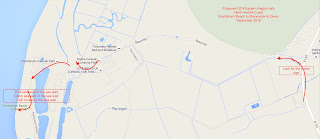Christmas Eve, after luncheon, and he was bored. There would be afternoon tea later, and then the long evening toward Midnight Mass. He could read through the long, deepening gloaming, but there was always the ambiguity: they became irritated by his reading: "Always has his head in a book, but never in his school books."
It was a bright clear afternoon (decades later he would know about high atmospheric pressure in winter, that the evening would cool and the night would freeze) as he and the dog walked up the hill, across the fields behind the house. Across the next field, and the next (the hedges and fences were no barrier to a skinny, teenaged country boy and a small mongrel dog); over the brow of the hill and then down across the fields to the South East. The A482 was somewhere to his right, the lane to Glan-Denys ahead in the valley. There was always water at the bottom of a valley.
The copse was unexpected, a delight, not an obstacle. And then the lane in the valley.
The lake was a total surprise: he'd had no idea.
Back in the summer he and his sister, together with her would-be boyfriend Cornflakes and a girl from Lampeter, had borrowed his father's Vauxhall Velox to get to the cinema in Aberystwyth.
Driving was a great pleasure. The long, narrow swooping roads to the coast were a joy. The big car purred as it swept them along. The others chatted as he revelled in his skill.
The attraction at Aberystwyth? The film, Summer Holiday, starring Cliff Richard and The Shadows. He'd been astonished when his sister and the girl had screamed every time the star appeared, and especially when he sang. Even Cornflakes, round as he was, bounced up and down in his seat with excitement!
Eventually the tedium ended, and he was able to drive them home: Cornflakes to one of the little coastal villages, his sister to Pantcoy and then the girl toward Lampeter. Around the bends and down the hills, with no-one to talk to, she became anxious and was clearly car-sick. She began fumbling with the door handle. He swerved off the main road, into the lane and stopped in a layby. She threw open the door and was violently ill by the side of the lane. He fetched water from the stream and she drank and washed her face. Gently and slowly he drove her home.
As he crossed the lane, on that cold Christmas Eve, there was the layby. The puddles of vomit, along with the memory, were long gone. And there, on his left, was the lake. It's gravelly shore stretched at right angles to the road. And on the shore was a raft. The usual thing, nothing special: A few planks lashed to four oil drums.
It took a matter of moments to drag it into the water. A long stick served as a pole, and in a few more moments he, the dog and the raft were a hundred yards from the shore, and sinking.
He'd spent the past 12 years or so in West Wales with parents and younger sister. The past 5 years had been at Aberaeron County Secondary School, on the coast, where every window overlooked Cardigan Bay, where lunchtimes were spent on the beach or around the harbour.
The family holidays were spent in a caravan at New Quay (the Welsh one, not the Cornish one). He and his father looked longingly at the sailing dinghies drawn up on the sand, and at the trip boats in the gentle surf, and at the mackerel boats as they brought their catch in for the holidaymakers. They knew every inch of every plank and line; every ha'lyard and stay; every gun'l' and thwart; every jib and main. In theory they could sail every one of them.
They knew the intricacies of the British Seagull outboard engine, how it worked and how to operate it. Even the magic of the misunderstood air-bleed screw!
They had once, as a family, taken the paddle steamer from Barry to Weston-super-mare. And back.
Sundays out were spent at Llangrannog, further South down the coast. His parents and sister were good swimmers; aunts, uncles and cousins, when they came to visit from England, were excellent swimmers. He hated swimming and scorned all attempts to learn or be taught. Boats were the thing: they kept you dry.
And now, for the first time in his life, he was afloat on his own, sinking, craft. Alone on an isolated lake in a Welsh valley. There was a skim of ice across the surface which broke as he paddled with his stick to get the doomed raft back to the beach; a thicker patch of ice broke the stick and left the stub in his hands.
Water welled up between the planks and froze at the edges.
No problem; the dog's lead (string) was long. Push the dog into the water, it'll swim to the beach and pull the raft along.
The dog didn't agree. It scrambled back onto the edge of the raft, its efforts pulling that edge a few inches lower into the water.
But that lifted the opposite edge a few inches out! He knelt at the edge and began paddling with his hands. His hands and the dog's hind legs combined to drift the waterlogged craft back toward the beach. It ran aground, and he waded the last few feet.
As he slipped quietly in through the back door his trousers, from the knees down, were rock hard ice. His shoes and socks were sodden. The dog was dry and as happy as he.
Afternoon tea was long past, and they served nothing but tension and unanswerable questions.
Midnight Mass was utterly tedious.














